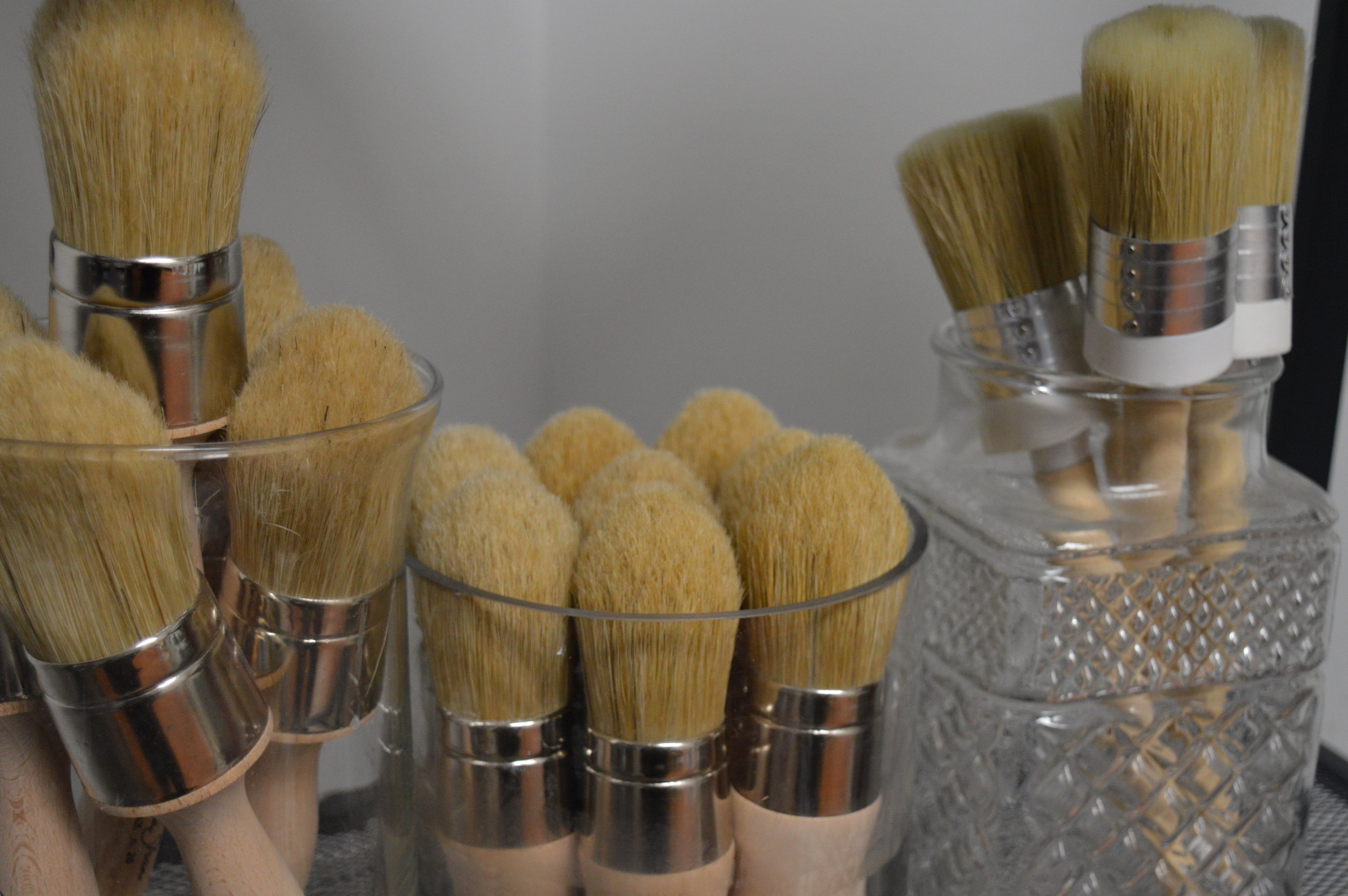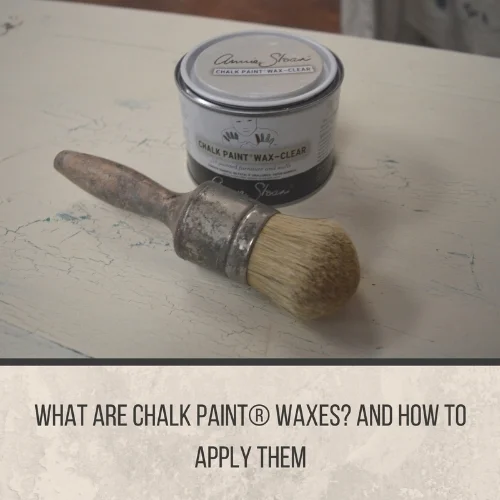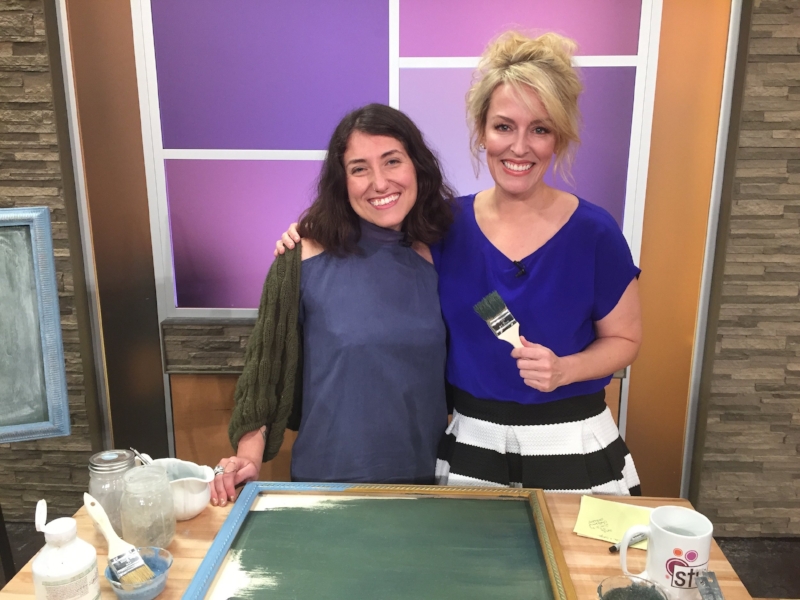
How to Open the New Chalk Paint® Litre Tin Lids
Have you bought an updated litre of Chalk Paint® but not been sure how to open the lid easily? Using these tips it should be a breeze for you.
Hello! Happy February. Our 2019 is in full swing, how about yours? Part of our new year has been an introductory to the updated packaging for the new Chalk Paint® litres. Have you tried the ‘global’ Annie Sloan paint yet? In case you’ve missed it, Chalk Paint® recently got a tiny update on the amount of clay in the formula, and therefore will be a little bit thicker in feeling going forward. We’ve been LOVING how creamy it is, and dare we say we didn’t know how it would ever possible for Chalk Paint® to get any better than what it’s been (since it’s so dreamy)… but it has. Our students and customers have been loving the update too.
The other part of that update is that the large tins will be transitioning over to litres from quarts, so you’ll be getting a tiny bit more bang for your buck as well. Opening the litre lids is a little bit of a learning curve, so we decided to highlight the best ways to open the lids without mangling them. All in all, they will be easier to press shut with just your hands going forward (instead of hammering them shut, eek).
Opening the tin
Ease the tin opener between the top of the lid and the edge of the tin.
Apply slight pressure and lift upwards.
Turn the tin a few degrees and repeat the motion. You will feel the air tight seal break and hear a “pop” noise.
Continue turning the tin until you have covered the whole circumference of the lid before attempting to pry the lid completely off.
Be as gentle and light handed as possible.
Following these steps will prevent the lid buckling or damaging the tin.
Closing the tin
To secure the lid after use, set in place on the top of the tin.
Place both palms on the lid and apply pressure down until you here a “pop”.
*The Wax, Lacquer, and Chalk Paint® tins are all the same, so you can use this method with every Annie Sloan tin. All metals are susceptible to some bending and denting if not handled gently.
If you haven’t made it to the ‘new’ formulated colors yet, visit us to get a quick painting demo to try it for yourself!
Happy Painting :)
What are Chalk Paint® Waxes and How to Apply Clear Wax
We want to teach you the quintessential waxing technique for Chalk Paint® Waxes- watch the demo videos with Clear Wax.
Have you worked with Chalk Paint® waxes? Waxing is a crucial step to finishing your work and creating a durable surface to seal the decorative paint. We're constantly perfecting our technique, and because we know there are many questions (as well as misconceptions) about it, we're off to task to share our tips with you! Feel free to also pop on over to our Chalk Paint® FAQs page.
The waxes come in four types: Clear, Dark (brown), White, and Black. They can be protective AND decorative at the same time. Waxes:
- are completely non-toxic when dried and cured, and even suited for 'child-safe' applications.
- should be at a slightly-melted crisco or butter-at-room-temp texture (sit in a sunny window or warm environment if they feel a bit firm to work with).
- fill the pores of a surface painted with Chalk Paint® decorative paint and cure to leave behind a hard surface that has bonded to the paint.
- in the case of Clear and White Waxes, are applied directly to the painted surface.
- in the case of the Dark and Black waxes, are applied over a wiped-back layer of Clear Wax (so you can control their depth)- the exception to the rule can be over Graphite since it's such a dark color to begin with.
- can be mixed together to create mid-tones like beige and grey.
- can be tinted with a drop of paint for an extra pop, if you need an exciting green or pink wax for example.
- can be layered up to 2-3 coats total for extra durability for heavy-traffic surfaces like cabinets and dining table tops (wiping back thoroughly and waiting 24-48 in between coats).
- dry within 24-48 hours for each coat, however need to be gently-used until they finish curing.
- cure and reach full hardness within a period of 2-4 weeks, depending on how many coats have been applied and humidity (again, gently use your surface depending on its usage- you can probably put your dishes back inside your cabinets, however that kitchen table will need to wait a bit longer to be ready for your dinner party!).
- are water-resistant.
- are interior-grade only.
- once fully dried and cured provide a brilliantly durable surface, which is easily maintained by wiping food spills, dirt, and dust away with a damp cloth or mild soap and water at most- we've also gotten crayon, marker, sharpie, highlighter, and other stubborn marks off by cleaning with more wax, which pulls it right up and out of the surface.
- are as durable as polycrylic-type topcoats when applied correctly and let to fully cure before heavy use.
- can be buffed to a soft satin sheen, or left relatively matte in finish.
Using wax brushes to apply all waxes ensures we don't apply too much or unevenly, and also prevents as much wasting of wax as possible. Here are some in-depth video demos of a preferred technique that works for most surfaces:
Part 1: Using Your Wax Brush to Apply Clear Wax
Part 2: Wiping Your Excess Wax Back, Finishing Up
And here's a concise recap of the waxing process to conclude:
Remember, patience is key when allowing topcoats to fully dry and cure during a DIY process. When you buy new furniture, topcoats have been allowed to fully cure before being put on a sales floor. We do have other topcoats with the same durability for different finish sheens (such as semigloss), for exterior projects, and others that might cure a tad bit sooner for heavy-traffic areas (ex; if you work with wax for your coffee table just keep in mind that you need time to let it cure). For all topcoats on tables we do recommend using placemats, coasters, etc. anyway to protect the finish as long as possible (nothing is completely iron-clad y'all). However we do say 'trust the wax!' because you can't beat it over hand-painted finishes, and can easily spot repair it if unexpected damages do occur.
Our Segment on Studio 512
That time we stopped by KXAN's Studio 512 for some fun with Miss Mustard Seed's Milk Paint...
Recently we had the chance to stop by Austin's local news station KXAN's Studio 512 segment to demo our 'Vintage' Chalkboard Class. We worked with Miss Mustard Seed's Milk Paint to create a usable chalkboard (usable if you write on it with real chalk, that is!) with a vintage look. What a fun time for us and the host Amanda! We were a but nervous going in, but always love to teach you so that helped dispel any butterflies. Here are some takeaways from the experience and the whole Milk Paint process:
- Being prepared is fabulous, because nothing will go exactly as planned. This is true in everyday life, for special events (like this video segment we did) AND in the DIY project realm.
- Milk Paint always starts at a 1:1 ratio of equal parts powder to water, and then you can add more of one ingredient or the other as needed- some days and working environments are more dry than others and you may need more water (which is why being prepared just in case is the best!)
- A great rule of thumb is to mix an equal part Bonding Agent in with your Milk Paint mix when painting over highly slick or manufactured surfaces (like the frame we used in the demo), to help that paint adhere.
- Quick projects like these are fun times to share with others, including with children (especially since it cleans up easily with soap and water and is non-toxic).
Sign up for your own date of 'Vintage' Chalkboards for a DIY take-home project as a way to learn some essentials about using Miss Mustard Seed's Milk Paint! And don't forget to watch the video segment. Happy Painting!
Our Brush Guide for Your Projects!
Our guide to choosing the best brushes for your projects when at our Shop & Studio!
What's the right brush to choose for your project? We've put together our simple, handy Brush Guide for selecting the best brush when at our Shop and Studio.
Annie Sloan Flat Brushes- Great for minimized brushstrokes when applying Chalk Paint® decorative paint, high-quality synthetic brushes in two different sizes.
Annie Sloan Pure (Natural) Bristle Brushes- Natural hair brushes will always possess slight texture, so you can create both subtle and enhanced texture with this brush that comes in three different sizes. Each hold a lot of paint to extend your brushstrokes when using Chalk Paint® !
Artisan Enhancements® 45mm Topcoat Brush- As a blend of fine natural and synthetic bristles, this brush is intended to minimize brushstrokes when applying liquid topcoats that otherwise might exaggerate the appearance of strokes (like glosses). They also extend brushstrokes well by holding a lot of paint, which also makes them a favorite for applying Miss Mustard Seed's Milk Paint.
Artisan Enhancements® European Wax Brush- This lightweight wax brush is great for starting, and is versatile due to size and length of handle. Its bristlehead is flexible yet slightly firm for ideal wax application.
Annie Sloan Wax Brushes- These pointed brushes are of the highest quality, allowing you to wax in tight corners and carvings. They come in two different sizes of both bristleheads and handles, so choose the best based on the size of your project and comfort for grip! Made in Italy.
Inside the Toolbox: Using Annie Sloan's Flat Brushes for Smooth Finishes
Why we love using Annie Sloan's Flat Brushes for smooth painted finishes.
Hello in the new year! For our first blog post of 2017, we wanted to jump right in and talk about smooth, sleek painted finishes. These are the quintessential contemporary, modern, and even Mid-century Modern finishes that are not only popular at the moment but timeless. As you know, Chalk Paint® by Annie Sloan is versatile for both smooth and rustic techniques. How do we achieve such looks though?
Since Chalk Paint® decorative paint is a bit thicker than other types of paint, achieving specific finishes can come down to the type of brush. Chalk Paint® is already relatively self-leveling (especially once a layer of Soft Wax is applied), so it's not difficult to use your brush for smooth finishes. To minimize the look of brush strokes, use Annie Sloan's Flat Brushes. As high-quality synthetic brushes, they've been made to specifically work well with her paint line. When painting, work the brush from one side to the next of each section of your piece, working 'with the grain.' Each layer of paint should be thin and allowed to dry thoroughly before the next. Adding a tiny bit of water in with your paint can also help spread each stroke nicely, with minimized appearance. Anytime you feel the need to slightly sand, don't hesitate! See our video below:
The Flat brushes come in two sizes, giving greater accessibility for different sized surfaces. The small size is thin and narrow, and perfect for trim and other small spaces. They're easy to clean with soap and water. We always stock both sizes in our brick & mortar shop and online.
*You may have also seen painting techniques where brushstrokes are painted haphazardly, in an almost cross-hatched effect. This is a technique that Annie Sloan displays well, which fools the eye into thinking the surface looks flat and even due to optical confusion. Try your hand with that using the Flat Brushes if you'd like as well!
Happy Painting xo.








